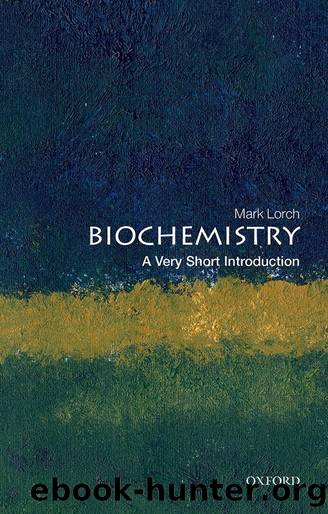Biochemistry: A Very Short Introduction by Mark Lorch

Author:Mark Lorch [Lorch, Mark]
Language: eng
Format: epub
ISBN: 9780192570628
Google: KRUuEAAAQBAJ
Amazon: B094W78SV3
Publisher: OUP Oxford
Published: 2021-05-26T23:00:00+00:00
Translation
By this point I hope it is clear that DNA and RNA are extremely similar molecules, both with sequences spelt out with a similar four-letter alphabet. Proteins, however, are very different beasts, being made up of twenty different amino acids. So translating the information contained in a gene sequence into a protein sequence needs a very different mechanism from the simple base pairing used in DNA to RNA information transfer.
Following the discovery of DNAâs structure, establishing the mechanism of translation was one of the most pressing questions of the time. The problem was simple. There are just four bases in nucleic acids. But genes somehow code for the twenty different amino acids found in proteins. So how can a four-letter alphabet be translated into a twenty-letter alphabet? What methods could biology use to get twenty from four?
One of the most notable attempts to resolve this came from Francis Crick. He saw the problem in the following way: The genetic code had to consist of non-overlapping triplets of bases. But if that is the case then how can one triplet be distinguished from the next. After all there is no punctuation in DNA. It is like trying to find three-letter words in SATEATEATS without any spaces. They could be SAT EAT EAT, or ATE ATE ATS, or TEA TEA, depending on where you started.
Crick came up with an elegant theory he called âcodes without commasâ. He took the sixty-four possible triplet codes and put them together in groups according to whether they had the same circular permutations (i.e. ACG, CGA, and GAC are in one group; CCG, GCC, and CGC form a second group; and so on). He then hypothesized that only one sequence from each group would be used to code for an amino acid. These he called âsenseâ codons. The remainder were termed ânonsenseâ. So if ACG and CCG are sense then the sequence ACGCCGACG can only be read ACG CCG ACG, because CGC CGA both give nonsense codons.
Also into the nonsense bin went AAA, UUU, GGG, and CCC because they would cause ambiguity about where a codon started (e.g. is CCCCGGG read CCC CGG or CCC GGG?). Crickâs code without commas theory gives us a total of sixty-four possible codons, and removing CCC, GGG, AAA, and UUU leaves us with sixty. Of those remaining, only every third codon is âsenseâ, neatly leaving twenty codons to code for the twenty amino acids.
The comma-free code was so elegant, and the numbers fitted so well that everyone believed it for the best part of five years. Until, in 1961, Marshall Nirenberg and Johann Heinrich Matthaei produced a stretch of RNA composed of just uracil. When they added it to a mix of ribosomes, tRNAs, and amino acids necessary to initiate translation, the result was a polypeptide of pure phenylalanine. According to Crickâs theory poly-uracil should have been a nonsense sequence, and so his code without commas theory was consigned to a dusty shelf of biochemical history.
In fact, the genetic code is much simpler.
Download
This site does not store any files on its server. We only index and link to content provided by other sites. Please contact the content providers to delete copyright contents if any and email us, we'll remove relevant links or contents immediately.
| Anatomy | Animals |
| Bacteriology | Biochemistry |
| Bioelectricity | Bioinformatics |
| Biology | Biophysics |
| Biotechnology | Botany |
| Ecology | Genetics |
| Paleontology | Plants |
| Taxonomic Classification | Zoology |
Sapiens: A Brief History of Humankind by Yuval Noah Harari(13052)
The Tidewater Tales by John Barth(12029)
Do No Harm Stories of Life, Death and Brain Surgery by Henry Marsh(6336)
Mastermind: How to Think Like Sherlock Holmes by Maria Konnikova(6235)
The Thirst by Nesbo Jo(5785)
Why We Sleep: Unlocking the Power of Sleep and Dreams by Matthew Walker(5641)
Sapiens by Yuval Noah Harari(4537)
Life 3.0: Being Human in the Age of Artificial Intelligence by Tegmark Max(4507)
The Longevity Diet by Valter Longo(4445)
The Rules Do Not Apply by Ariel Levy(3905)
The Immortal Life of Henrietta Lacks by Rebecca Skloot(3826)
The Body: A Guide for Occupants by Bill Bryson(3800)
Why We Sleep by Matthew Walker(3771)
Animal Frequency by Melissa Alvarez(3755)
Yoga Anatomy by Kaminoff Leslie(3701)
Barron's AP Biology by Goldberg M.S. Deborah T(3631)
The Hacking of the American Mind by Robert H. Lustig(3579)
All Creatures Great and Small by James Herriot(3515)
Yoga Anatomy by Leslie Kaminoff & Amy Matthews(3395)
